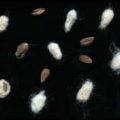Elmer Ivan Applegate
Great Migration Botanist
March 31, 1867
Today is the birthday of an important pioneering Oregon botanist Elmer Ivan Applegate.
Elmer was born near Ashland. His grandfather, Lindsey Applegate, was a wagon train leader, and he led many settlers to Oregon during the "Great Migration" of 1843.
Elmer was the oldest in his family of six children. He grew up on a 5,000-acre ranch where he mastered the demands of ranch life, and it was on the ranch that Elmer discovered his love for botany.
In 1895, Elmer graduated from Stanford, and after graduating, he spent time with the USDA's Frederick Colville - the botanist who, along with Elizabeth Coleman White, helped tame the wild blueberry.
As one of the most prominent Oregon botanists of the 20th century, Elmer's signature work focused on trout lilies (Erythronium) "er-rith-THRONE-ee-um".
The trout lily is a native plant featuring nodding, freckled, yellow flowers that bloom in early spring in woodlands and on north-facing slopes. Trout lilies bloom in spring from March to May. As a spring ephemeral, they often bloom before the trees leaf out, and once the forest canopy fluffs out, the trout lily bloom disappears.
At the base of the trout, lily are these mottled brown and green leaves, which inspired the name of the plant because they look like the markings on brook trout. Those spots have also inspired the name fawn lily.
Trout lily is also known by common names like the dogtooth violet or the adder's tongue. The dogtooth name refers to the tuber of the trout lily which is underground. The tuber looks like a smooth, white fang. The adder's tongue refers to the curled, serpent-like, pointed leaf-tips, and the six stamens with anthers that look like fangs.
Here are some fun facts about the trout lily:
- Trout lilies are short; they grow 6 to 8 inches tall.
- Young plants have only one leaf, but mature plants sport two leaves. In fact, until that second leaf appears, the plant cannot flower.
- Trout lily colonies are very long-lived, and some are 200 to 300 years old.
- Trout lily leaves and bulbs have been used for medicinal purposes, such as contraception.
Mary Oliver wrote a poem called Trout Lilies:
It happened I couldn't find in all my books
more than a picture and a few words concerning
the trout lily,
so I shut my eyes,
And let the darkness come in
and roll me back.
The old creek
began to sing in my ears
as it rolled along, like the hair of spring,
and the young girl I used to be
heard it also,
as she came swinging into the woods,
truant from everything as usual
except for the clear globe of the day, and its
beautiful details.
Then she stopped,
where the first trout lilies of the year
had sprung from the ground
with their spotted bodies
and their six-antlered bright faces,
and their many red tongues.
If she spoke to them, I don't remember what she said,
and if they kindly answered, it's a gift that can't be broken
by giving it away.
All I know is, there was a light that lingered, for hours,
under her eyelids - that made a difference
when she went back to a difficult house, at the end of the day.
This post was featured onThe Daily Gardener podcast:
helping gardeners find their roots,
one story at a time


